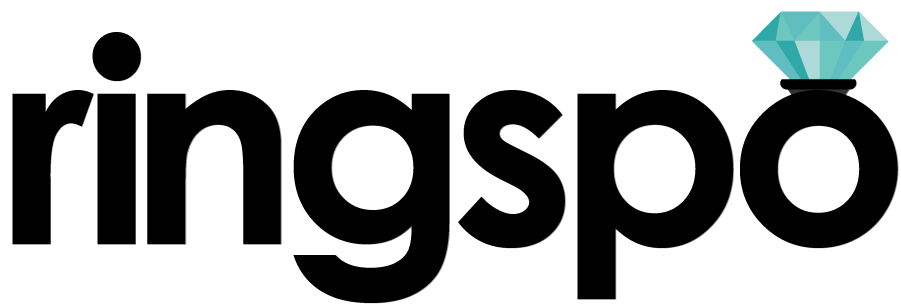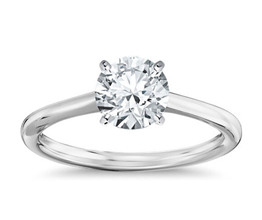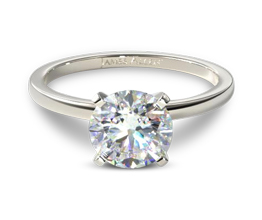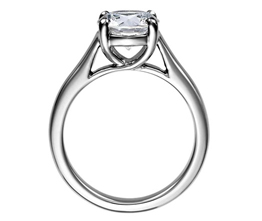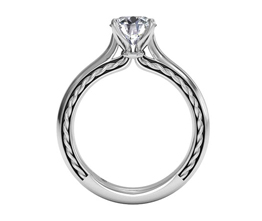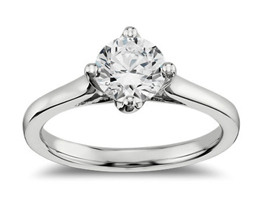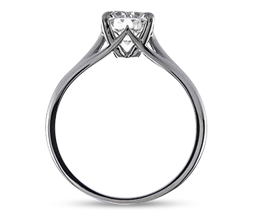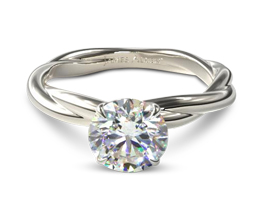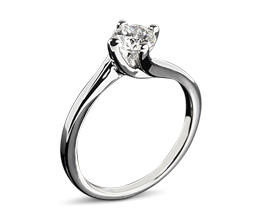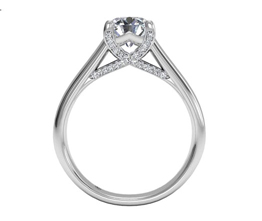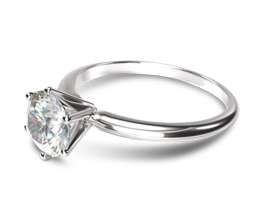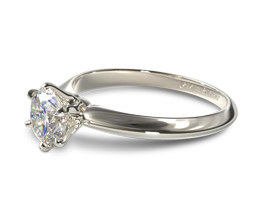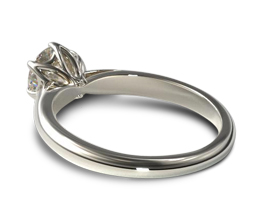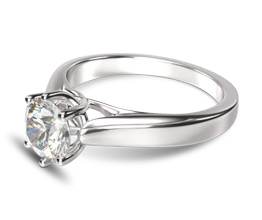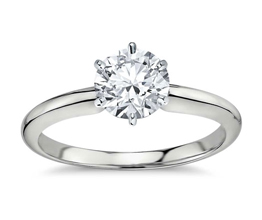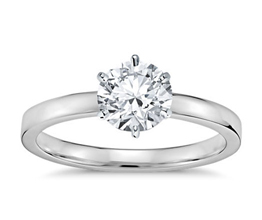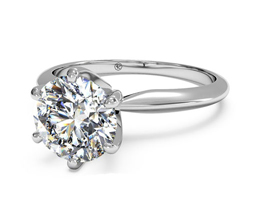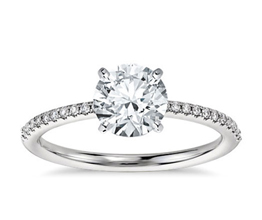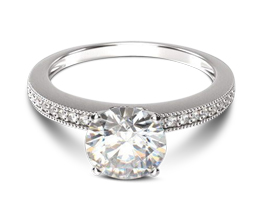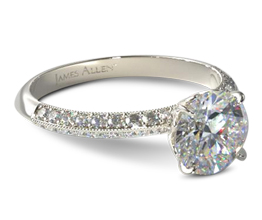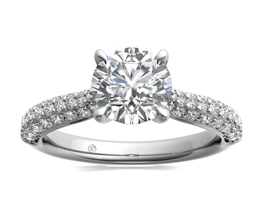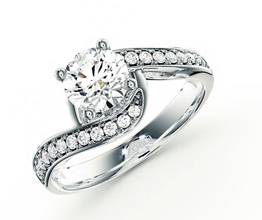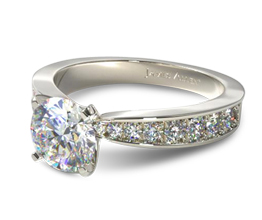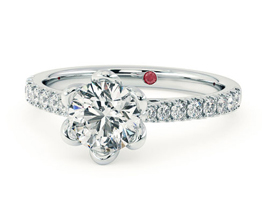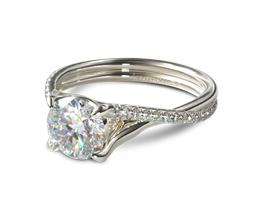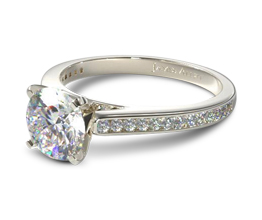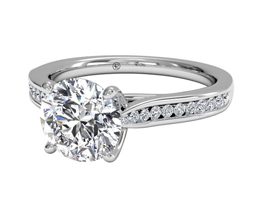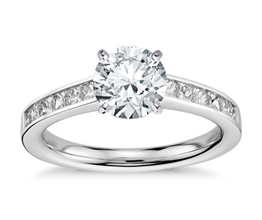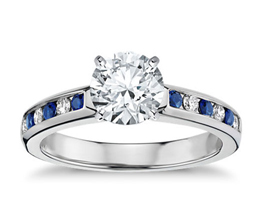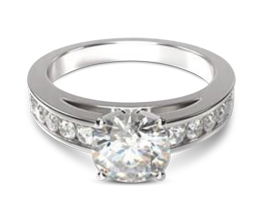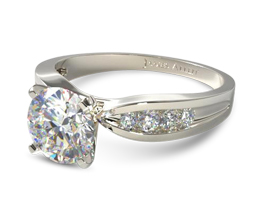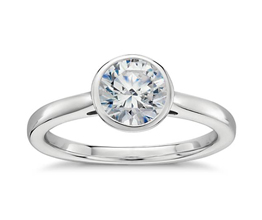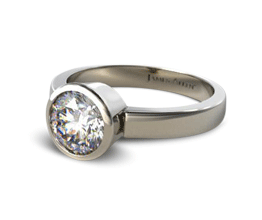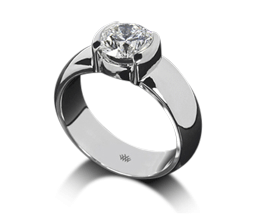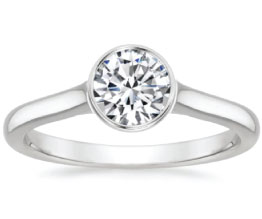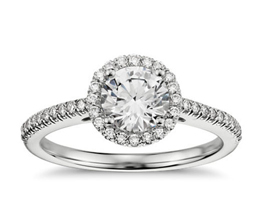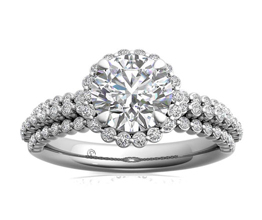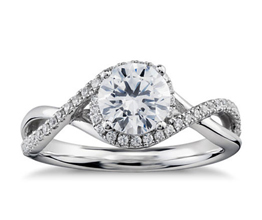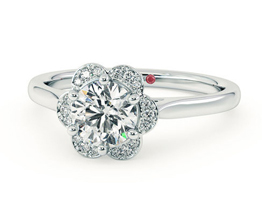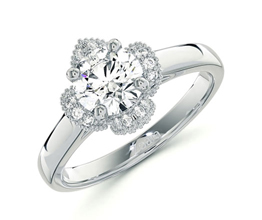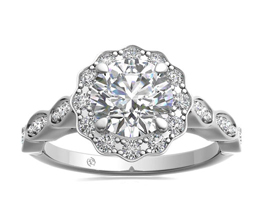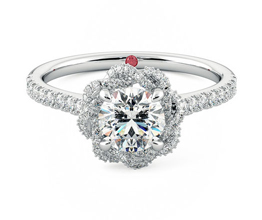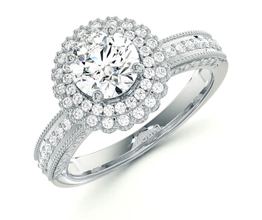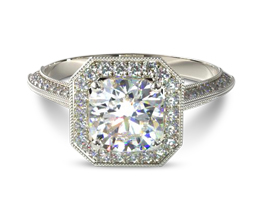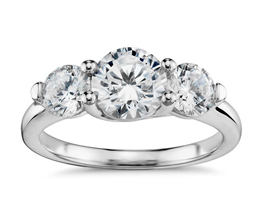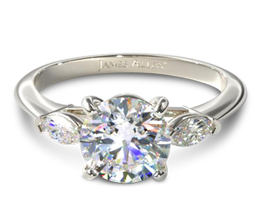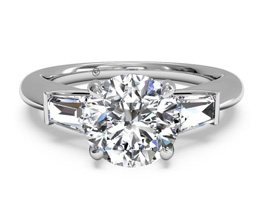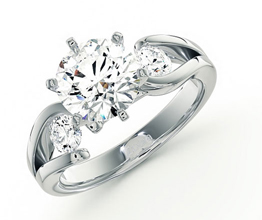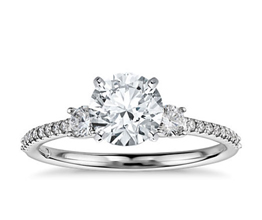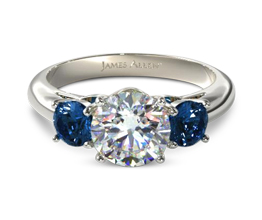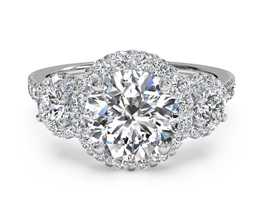Round engagement rings
All you need to know about round brilliant diamonds
Ringspo is reader supported
Ringspo is reader-supported, which means we may receive a commission if you click a link to a retailer & subsequently make a purchase.
We feature links to several retailers to help readers find the one that is the best fit for them. Find out more about how Ringspo works here.
Engagement rings with round diamonds are by far the most popular out of any type of ring – they make up around 75% of all diamond engagement rings sold.
But many round brilliant diamonds that are available are cut to hit a certain carat weight, rather than being cut to sparkle as brilliantly as possible.
To help you avoid those poor quality stones and make sure you get a diamond with incredible sparkle, this page is going look at:
- Some key background information about round brilliant engagement rings – what they are and why they have become so popular
- What’s good about round brilliant engagement rings
- What’s not so good about round engagement rings
- A selection of round engagement ring setting styles
- A guide to getting the best round brilliant diamond
- Recommended specs for your stone
Do you really know the 4Cs?
Much of the information on this page will focus on the diamond part of your engagement ring, as getting the rock right is key to getting an awesome ring for a great price. If you’re not familiar with the 4Cs of diamonds then I’d recommend reading this page which gives an overview of what you really need to know.
Round cut diamonds have been around for hundreds of years, but the modern round ‘brilliant’ cut was developed in the 1920s by a French mathematician called Marcel Tolkowsky as part of his PhD thesis.
He was looking to maximize the amount of light that was reflected back by a diamond, to make sure that it sparkled as brightly as possible and he achieved this by creating a shape that has 57 ‘facets’ (sides), as well as a recommended set of proportions and angles between the facets, which looks a little bit like the diagram below:
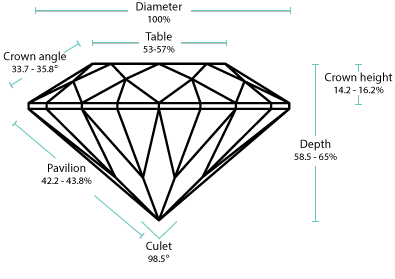
Although it looks complicated, what you really need to know is that the closer to these ‘ideal’ proportions a diamond is, the more it will sparkle.
Although it looks complicated, what you really need to know is that the closer to these ‘ideal’ proportions a diamond is, the more it will sparkle.
The exact angles have been tweaked slightly over the years as diamond companies began to use lasers and computer modelling to calculate how to return the most light possible back to your eyes, but these are the proportions that diamond laboratories take into account when grading a diamond’s cut grade from ‘poor’ to ‘excellent’.
Why round brilliant diamonds make a great choice
Round brilliant diamonds sparkle brilliantly
Round brilliant diamonds’ whole reason for being is to be the sparkliest sons of guns out there, and if your diamond has been cut well then it will definitely deliver.
No other diamond shape can compete with the fire, brilliance and scintillation of a well cut round brilliant stone and the ‘optical performance’ of the light being reflected can make a stone look larger, improve the colour, hide flaws and imperfections and generally make a ring look much more impressive.
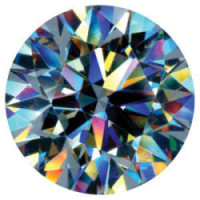
There’s a lot of choice when it comes to round diamonds
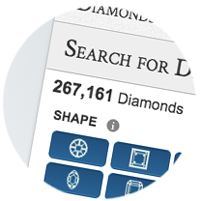
Because they are so popular, diamond producers prioritise the production of round brilliant diamonds, which means there are always a huge number of stones to choose from. The advantage of this is that no matter what your budget is, or how picky you are about the stone you want, you are almost certainly going to be able to find a stone to fit the bill.
So, if you know that you want to go for a 1.5 carat stone which
excellent in cut but scores lower in color and clarity, you’ll be able to find it. Equally, if you want to go for a smaller stone that is the highest quality for cut, color and clarity, the perfect stone for you is out there too.
Round diamonds are easy to compare
Round brilliants are the easiest shape of stone to buy too, as they are subject to the most testing by laboratories. They are the only shape that are given a ‘cut’ grading by labs, which means that you can be sure of the quality of the stone that you are buying.
The cut grading, going from Poor to Excellent (with some retailers offering a cut above excellent also) is super important as it’s the biggest factor that determines how much your stone will sparkle and therefore how impressive it is. When buying any round brilliant stone online, retailers will enable you to sort by cut grade which means that you can discount any really poor stones that aren’t going to sparkle well straight away.
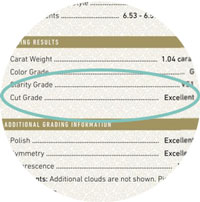
Round brilliant diamonds are very versatile
Round brilliant stones are extremely versatile – they will work in pretty much any ring style, from standing alone in a solitaire to being the center-stone in a blingy round halo engagement ring setting. No matter the setting chosen, a round brilliant stone will work.
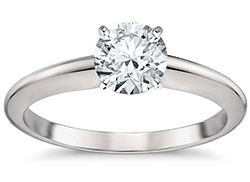

Round brilliant diamonds are easy to upgrade
If you decide to upgrade your engagement ring in the future, selling a round brilliant can be much easier than other shapes as they are the most popular shape, so there will always. be a market for them.
While this maybe isn’t something you are considering right now, it can be comforting to know that if in the future you want to know how to sell an engagement ring, by choosing a round diamond you have made the process significantly easier.
Things to watch out for when considering round brilliant diamonds
Round brilliant diamonds are the most expensive shape
One big downside of round brilliant engagement rings is that the stone itself is almost always considerably more expensive than any other shape of diamond of the equivalent size and quality. This difference in price is for a few reasons:
1) Wastage
Creating the round shape – chipping off the corners to make it a circle – results in a lot of the rough diamond hitting the cutting room floor and having to be thrown away. This means that for an equivalent 1 carat finished stone, a larger, and more expensive, piece of rough diamond is required to start with compared to, say, a Princess cut diamond.
2) Popularity
I’m probably not going to win the nobel prize for economics by stating that the price of anything – oil, iPhones, McRibs – is driven by demand.
This principal is definitely true for round brilliant diamonds – they’re the most popular shape and retailers know that people will pay a premium for them.
3) Labor-intensity
Creating a well cut round brilliant diamond is more labour-intensive than other shapes. It requires a more skilled craftsman and takes longer than other cuts of diamonds to ensure that all of the facets are the right size and the angles between them are correct.
The result of all this is that the round brilliant is significantly more expensive than all of the other shapes of diamonds out there, even ones that sparkle nearly as well.
The two stones that sparkle the best are the oval, which is basically an elongated round brilliant, and the Princess cut, which takes the principles of the round brilliant and applies them to a square shaped stone.
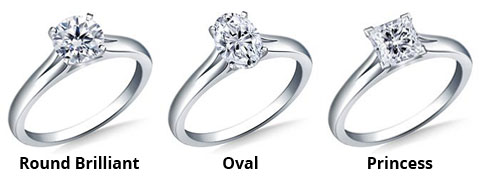
The table below shows the price difference between a round brilliant diamond, an oval shaped diamond and a Princess cut stone at exactly the same carat weight and quality from one of my recommended retailers.
The quality tested was:
- 1 carat
- Color F
- Clarity VS1
Here’s how the prices compare:
| SHAPE | PRICE (US$) | DIFFERENCE (US$) | DIFFERENCE (%) |
| Round Brilliant | 6,610 | ||
| Oval | 4,528 | -2,082 | -31.5 |
| Princess | 4,446 | -2,164 | -32.7 |
Over a 30% difference is absolutely huge – that could be your honeymoon flights, an incredible wedding gift or a weekend in Vegas – the choice is yours!
The actual difference will depend on the specs of the stone that you’re looking at, but it’s definitely always worth looking at alternative shapes to the round brilliant to see what you can get for your budget.
Round brilliant engagement ring settings
As the most popular shape of diamond, there are an almost infinite number of combination of ring setting style, ring setting metal, diamond size and diamond quality for round engagement rings.
In this section we’re going to look at some of the most popular styles out there, although it’s definitely not a definitive list. Each of the jewelers will also stock the majority of the styles listed, as well as many other variations as well.
Click through to any of the rings to find out more about it, or if you see a setting that you like but it’s not quite perfect then each retailer will have a large number of variations – one of which is likely to be perfect for you.
Four prong solitaire round brilliant engagement rings
The number one setting for the round cut diamond ring is the classic round solitaire, or 4 prong setting.
As well as being simple and elegant, the solitaire setting allows the most light possible to enter the stone, which allows it to sparkle to the maximum of its potential. Plus, with less previous metal used than in more complicated and ornate settings, the solitaire setting is among the most inexpensive.
Scroll across to check out a selection of round solitaire engagement ring options, and click through to find out more about each one.
6 prong solitaire settings
A variation on the classic 4 prong setting is the 6 prong engagement ring, also sometimes known as the ‘Tiffany setting’, as Tiffany’s is credited with inventing it back in the 19th Century.
The 6 prong setting can be a good choice for larger brilliant cut diamonds, usually those which are over 2 carats, as the extra prongs will give a little bit of extra security, without adding any extra cost or affecting the sparkle of the stone at all.
Pavé round brilliant engagement rings
Pavé settings cover areas of the ring band in a large number of tiny diamonds, effectively ‘paving’ the ring with stones. This gives an incredible effect as the diamonds on the ring band will catch the light and shimmer at different angles to the center stone, making the whole ring sparkle.
There are many variations on pavé settings, each of which use a different number and size of diamonds – which can have a significant effect on the price of the setting itself.
Round channel-set engagement rings
Channel settings are similar to pavé settings in that they add smaller diamonds to the band, but they are usually larger than the diamonds used in pavé settings, and are sunk into the band so that they sit flush.
Round bezel set engagement rings
Bezel settings are a popular setting style as they offer a great combination of simple and classic look an excellent protection for the diamond.
The entire edge of the stone is wrapped in metal, which offers excellent protection for the delicate edge of the diamond. This is especially useful if the wearer has an active lifestyle, or is just a bit of a klutz.
The bezel does, however, slightly reduce the amount of light that can enter the stone from the side, which may reduce the sparkle slightly.
Halo round brilliant engagement rings
Halo settings feature a ring of smaller stones around the center stone. There are some big advantages to this – it adds considerable bling to the ring, without the large associated increase in price that a dramatically larger center stone would add.
That’s not to say that they are an inexpensive option though – the extra diamonds and the craftsmanship required to produce the halo setting does add up. However, what it does mean is that the high number of smaller, supporting diamonds will catch the light in addition to the center stone, meaning that your ring will sparkle brilliantly from any angle.
Three stone round brilliant engagement rings
Three stone engagement rings are also known as ‘past, present and future’ rings, as the three stones are said to represent the past, present and future of your relationship.
The advantage of them is that you can get a higher total carat weight of diamond for your ring at a reduced price to buying one large center stone. Three 1/3 of a carat stones on a ring is much cheaper than a one carat solitaire.
The side stones don’t need to be the same shape or even the same stone as the center – rubies, sapphires or emeralds can all be great choices for the stones.
Round brilliant diamond buying guide
Making the right decision on the center stone for your engagement ring is key to ensuring that you get an absolutely dazzling ring and real value.
This section will talk you through three of the 4Cs for round brilliant diamonds so you can ensure you get an incredible stone. We’re going to look at:
- Cut
- Color
- Clarity
- Carat
Once you’ve got this information dialled in, you’ll be in a great position to match your diamond to a setting and you’ll have an incredible engagement ring.
Round brilliant diamond ‘cut’ quality
Diamonds come out of the ground as rough chunks of carbon that are often pretty dull to look at. The cut is a grading of how well a diamond has been cut and polished from this rough state to the ideal proportions that were at the top of the page.
I can’t stress enough that cut is the most important of the 4Cs – it has by far the biggest effect on how impressive a round engagement ring is. Always buy the very best cut that you can afford, even if you have to make some sacrifices on other attributes like color and carat to be able to buy a stone with a higher cut grade.
The Cut scale
The cut scale was originally developed by the Gemological Institute of American (GIA) but is now used by pretty much everyone.
The scale runs from Excellent to Poor, with diamonds getting further from the ideal shape as you go down the grades:
To know why the cut grade is so important, you need to understand what happens when diamonds differ from the ideal proportions.
Too shallow
If a diamond is cut too shallow, the majority of the light will pass straight and won’t bounce back to your eyes. This will reduce the sparkle and make it appear opaque and glassy. Not good.
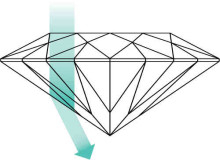
Too deep
If the stone is cut too deep the light will be reflected off the bottom of the stone at the wrong angle, rather than back to your eyes. This will make it appear smaller from the top and can result in a dark shape appearing in the center of the stone.
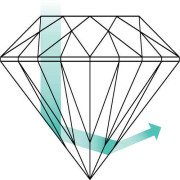
Just right
A diamond cut to ‘excellent’ or ‘ideal’ proportions will reflect as much of the light that enters the diamond back to your eyes, resulting in the incredible sparkle that you want from your diamond:
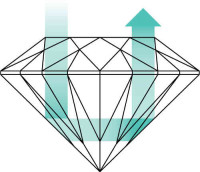
Recommendation: Jewelers play on people’s obsession with diamond size and ignorance of the importance of cut to maximise profit, but if you don’t want to get stuck with one of the larger but poorly cut diamonds that just doesn’t sparkle, make sure you go for the highest cut grade you can.
I recommend ‘excellent’ or ‘ideal’ (the terminology sometimes changes depending on the retailer), to make sure that you get a dazzling diamond that will do your engagement ring justice.
Round brilliant diamond color
OK, onto the second C – color. Diamond colors range from pure white through to yellow. White diamonds are rarer and more desired than yellow stones, but also more expensive.
The difference between diamonds that are close to each other on the scale is very small, to the extent that even a trained gemologist can struggle to tell the difference between, say, a D color and an E color diamond.
The full color scale runs like this:
As you can see, the change in color is quite slight between grades that sit close to each other one the scale.
And once a diamond is placed in a ring setting, the differences are even less obvious. Ring settings limit the amount of light that can enter the diamond, evening out the color across the different grades.
Recommendation: My recommendation for color for a round brilliant is color grade H. It will still look extremely white, but will be significantly less expensive than the highest color grades.
Color D: Brilliantly white, but very expensive:
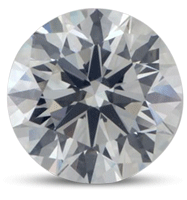
Color H: Great mix of color and value:
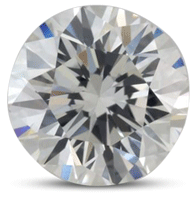
Color J: Darker tones clearly visible
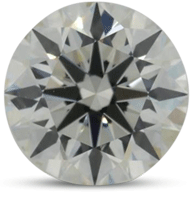
Round brilliant diamond clarity
The third C, clarity is a measure of the number of flaws that a diamond contains. The flaws are also known as ‘inclusions’ and are tiny impurities that snuck in when the diamond was being formed.
Clarity is the least important of the 4Cs, but it’s often the one that jewelers pay the most attention to when showcasing diamonds as it’s easy to demonstrate the different clarities using a microscope. However, when the diamonds are viewed with the naked eye, all but the bottom few grades will be ‘eye clean’: they will appear absolutely perfect.
The scale runs from ‘Flawless’ at the top, to ‘Included’ at the bottom:
The key thing that you are looking for for your diamond is that it is ‘eye-clean’ ie. that the inclusions can’t be seen when viewed with the naked eye, rather than being inspected with a microscope.
Any of the grades down to VS2 – VS2 included – will definitely be eye-clean. Some stones at SI2 and SI1 may be eye-clean, but to be sure you would need to examine the individual stone.
To see this in action, click here to check out a selection of SI1 clarity round brilliant diamonds at James Allen. You should be able to see that most of them do not have any visible flaws, even at the high magnification that they’re shown at. Some may have small flaws easily visible though, and those are the ones to avoid.
One thing to note is that you’re looking at the diamonds at 20x magnification, which is higher than gemologists use when they examine diamonds. So, if you can see some tiny imperfections that are sort of hard to see at this magnification, then don’t worry about them – they won’t be visible in real life once the diamond is set in a ring.
If you’re not sure about that, move the zoom function on the right of the image to 1x, rather than 20x to make the diamond actual size. Can you still see the inclusions?
Recommendation: VS2 clarity is the grade to go for from any jeweler to ensure that the stones will definitely be eye-clean. If you want to see whether you can find a Slightly Included stone to fit in your budget, then ensure that you use a jeweler that provides magnified images of every stone. My recommendations are:
Stones without any inclusions are much rarer than those with flaws, which makes them more expensive.
To demonstrate the different in price that clarity can make, I looked at the prices of a round brilliant diamond on one of my recommended retailers, and just changed the clarity.
The other specs for the diamond were:
- Cut: Ideal
- Carat: 1 carat
- Color G
Here’s how thee different clarities compared:
| Clarity | Price (US$) | Price difference (AU$) | Price difference (%) |
|---|---|---|---|
| IF | 10,330 | 0 | 0 |
| VVS1 | 9,694 | -636 | -4.3 |
| VVS2 | 9,270 | -1,060 | -10.3 |
| VS1 | 7,160 | -3,170 | -30.7 |
| VS2 | 6,400 | -3,930 | -38.0 |
| SI1 | 5,570 | -4,760 | -46.1 |
| SI2 | 4,180 | -6,150 | -59.5 |
| I1 | 4,100 | -6,230 | -60.3 |
As you can see, changing the clarity of the stone makes a huge difference to the price, and a SI1 is 46% less expensive than a flawless stone.
The exact difference in the cost of your stone will depend on the size and the other characteristics that you’re looking for, but by choosing VS2 or SI1 you will save a considerable amount of money while your stone will still look perfect.
Round brilliant diamonds and Carat Weight
Carat weight is something that people often get overly hung-up on. They want to choose a stone with a certain carat weight, even if it means that they end up making sacrifices on other, more important attributes of the ring.
The relationship between a diamond’s carat weight and its visible size isn’t always a direct one. When we judge a diamond’s size, we look at it from the top – known as the ‘face up’ position in the jewelry trade. However, much of the weight of a diamond is actually carried on the bottom half of the stone, where it can’t be seen.
The images below show the difference in size for round cut diamonds at a range of carat weights:
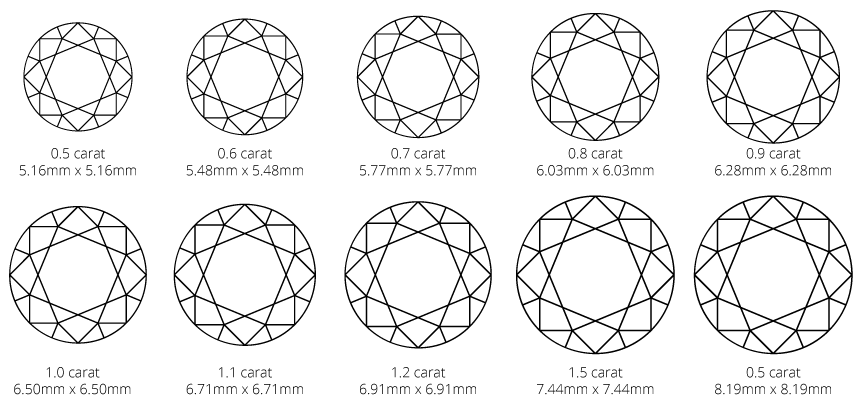
Hopefully you can see that increasing the carat weight doesn’t necessarily translate into a much visibly larger diamond. Changing the size from 0.8 carat to 1 carat is an increase in width of less than 0.5mm – less than 10%. However, the difference in price will be much more significant – about a 70% increase:
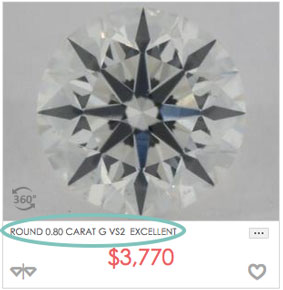
Click here to check out today’s prices for a 0.8 carat round brilliant diamond
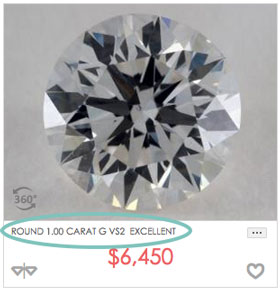
Compare to prices for a 1 carat round brilliant diamond here
The priority that you place on diamond carat weight and how bit you want to go is totally up to you. However, my recommendation is that you definitely don’t make it the most important attribute when choosing your engagement ring. Get the setting you love, find a diamond with a great cut that is going to sparkle brilliantly, make sure that it is eye-clean and has a good color and then see what carat weight you can fit into your budget.
A well-rounded diamond with excellent sparkle will much much more impressive than a big stone with obvious flaws.
Round brilliant diamond certification
The fifth C, and a very important one too. When looking at any diamond, you need to ensure that any diamond that you’re looking at is a ‘cert stone’, which means that it has been assessed, graded and coded with a laser by an independent lab.
Each certificate has a unique report number and detailed information about the stone, covering the four Cs, the height, depth and other info. As well as providing assurance that the stone that you’re buying is the quality that you are paying for, a certificate also proves what you’re buying is not a substitute.
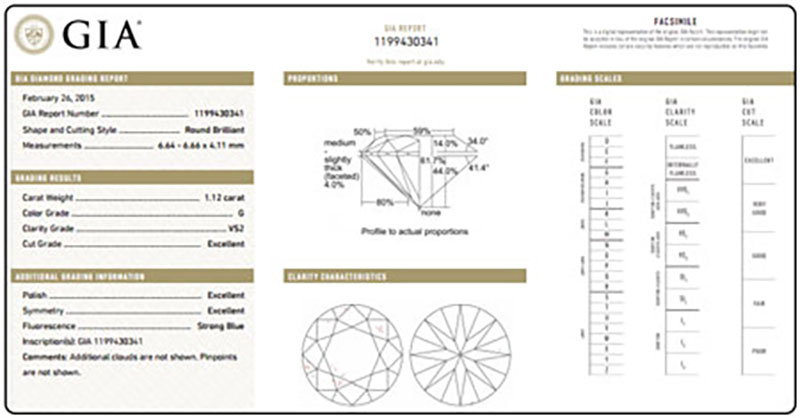
The lab to trust and to look for certification from is the non-profit Gemological Institute of America (GIA). It’s the most internationally recognised and generally seen as the most impartial of all of the gem labs.
The reason that the GIA is so well respected is because most others labs are part of trade bodies that contain jewelry retailers, or are ‘for profit’. While the GIA is very consistent with its gradings, the others have a reputation for being overly generous. What the GIA say is merely a diamond with a ‘good’ cut, maybe be graded ‘excellent’ by another lab, with an excellently large price to match.
Diamond certificates are what makes buying online safe and the best way to get a fantastic diamond at the lowest price. Knowing that each diamond you’re considering has been measured and graded by independent experts allows you to make an informed decision. You can take your time to consider the differences between diamonds and make sure you choose what experts have graded as the best stone, meaning that you get your perfect engagement ring at the best possible price.
Recommended round diamond specs
These specs are the minimum that we recommend to ensure that the diamond on your round brilliant engagement ring looks fantastic.
You can of course go higher than these specs, if your budget allows, but for many of the characteristics you are paying for improvements that are very difficult, if not impossible, to see by the naked eye, especially when mounted in a ring setting.
If you’re unsure about what any of these terms mean, check out this page which talks you through them all.
Click below to visit our top recommended retailer and see their currently available selection of round brilliants:
| Clarity: | VS2 / SI1 |
| Colour: | H |
| Cut: | Excellent |
